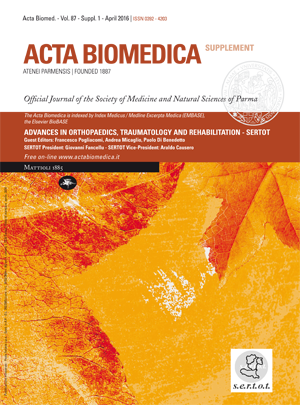Rotational osteoplasty and bioabsorbable polylactate pin fixation in Pipkin type 2 fracture with acute osteochondral defect: a case report
Keywords:
Pipkin fracture, femoral head fracture, osteochondral injury, osteochondral defect, rotational osteoplasty, osteochondral transplant, bioabsorbable pinAbstract
Pipkin fractures are relative rare high-energy lesions characterized by an intra-articular fracture of the femoral head after posterior hip dislocation. Early anatomic reduction and stable fixation are the main goals of treatment. This case evaluates the outcome of managing Pipkin type 2 fracture with acute osteochondral defect of the femoral head using “rotational osteoplasty” and bioabsorbable polylactate pin fixation. 24-year-old male patient was involved in a motorcycle accident, suffering from a left hip fracture-dislocation, and pelvic Computed Tomography revealed a Pipkin type 2 lesion. An open urgent treatment was performed. After anatomic reduction of the femoral head fragment a large osteochondral defect in the anterior-superior weight bearing surface was evident. The pattern of the fracture allowed us to perform a “rotational osteoplasty” including rotation of the femoral head fragment, to obtain an osteochondral cartilage congruence of the anterior-superior surface. Stable fixation was obtained by three bioabsorbable polylactate pins. At four-year follow up the patient had an excellent outcome and Magnetic Resonance Imaging (MRI) showed fracture healing, minimal signs of arthritis, excluding osteonecrosis of the femoral head. The reported case confirms that Pipkin fractures are very insidious surgical urgencies. In selected cases, “rotational osteoplasty” may be an alternative to osteochondral transplant for acute osteochondral defect of the femoral head. Bioabsorbable polylactate pin fixation allowed us to have a stable fixation evaluating the bone healing process and vitality of femoral head by MRI.
Downloads
Published
Issue
Section
License
This is an Open Access article distributed under the terms of the Creative Commons Attribution License (https://creativecommons.org/licenses/by-nc/4.0) which permits unrestricted use, distribution, and reproduction in any medium, provided the original work is properly cited.
Transfer of Copyright and Permission to Reproduce Parts of Published Papers.
Authors retain the copyright for their published work. No formal permission will be required to reproduce parts (tables or illustrations) of published papers, provided the source is quoted appropriately and reproduction has no commercial intent. Reproductions with commercial intent will require written permission and payment of royalties.



